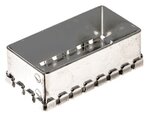aaron_do
Member level 3
Hi all,
my questions is what is the best way to shield a PCB? Assume I have bottom and top metal covers for my PCB. My PCB has a ground plane. Should my shield simply connect to the ground plane all around the edge of the PCB? The alternative is to have a ring of metal around the edge of the PCB with vias through the PCB to form a kind of side wall. This side wall would connect to the PCB ground at only one point on the PCB, and my top and bottom shield covers would be soldered to the shield. I suppose I could also not connect the shield to ground at all...
Which option is better, and which is more commonly done in practice? I have seen several designs which only have a top cover, and I believe the PCB ground plane forms the bottom of the metal box. My understanding is that this isn't really optimal as the currents flowing in the PCB ground plane will result in fields outside the box, and also make the inside of the box susceptible to fields on the outside.
Any comments are welcome.
thanks,
Aaron
my questions is what is the best way to shield a PCB? Assume I have bottom and top metal covers for my PCB. My PCB has a ground plane. Should my shield simply connect to the ground plane all around the edge of the PCB? The alternative is to have a ring of metal around the edge of the PCB with vias through the PCB to form a kind of side wall. This side wall would connect to the PCB ground at only one point on the PCB, and my top and bottom shield covers would be soldered to the shield. I suppose I could also not connect the shield to ground at all...
Which option is better, and which is more commonly done in practice? I have seen several designs which only have a top cover, and I believe the PCB ground plane forms the bottom of the metal box. My understanding is that this isn't really optimal as the currents flowing in the PCB ground plane will result in fields outside the box, and also make the inside of the box susceptible to fields on the outside.
Any comments are welcome.
thanks,
Aaron
